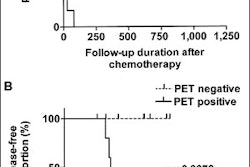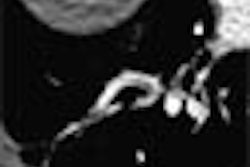A study from the U.K. concluded that use of the muscle relaxant hyoscine butylbromide (Buscopan) can produce better colonic distension for virtual colonoscopy, giving providers an alternative to glucagon, which has been shown to be generally ineffective for this purpose.
But the jury is still out on the utility of IV Buscopan, as two other studies concluded that it did not significantly improve colonic distension prior to CT imaging. Taken as a whole, the results suggest that the drug's benefits in virtual colonoscopy may be subtle, if they exist at all.
Buscopan (Boehringer Ingelheim, Ingelheim, Germany) is used routinely in Europe, Asia, and Australia for virtual colonoscopy, but is not yet approved for use in the U.S.
U.S. providers who use muscle relaxants have traditionally relied on IV glucagon hydrochloride. But that drug has fallen out of favor in the wake of two studies concluding that it does not improve distension when the colon is insufflated prior to CT imaging in virtual colonosocopy (European Radiology, March 2002, Vol. 12:3, pp. 525-530, and American Journal of Roentgenology, July 1999, Vol. 173:1, pp. 169-172).
The U.K. study, which appears in the online edition of Radiology, supports the routine use of Buscopan in virtual colonoscopy.
"Hyoscine butylbromide is an anticholinergic compound that acts predominantly by blocking parasympathetic ganglia, causing relaxation of visceral smooth muscle," wrote Dr. Stuart Taylor, Dr. Steve Halligan, and colleagues. "Administration...is standard practice during double-contrast barium enema examinations because it significantly improves colonic distension. On the basis of this evidence, most European workers routinely use hyoscine butylbromide during (virtual colonoscopy).... Collapsed segments are a leading cause of both missed disease and false-positive diagnosis during (VC), and any substantial reduction in the prevalence of poorly distended segments would justify the use of hyoscine butylbromide" (Radiology, online edition, August 27, 2003).
Buscopan is not without side effects, however, and may precipitate glaucoma, urinary retention, or even cardiac ischemia in some patients, added the group, from St. Mark's Hospital in Harrow, Middlesex, U.K.
The authors sought to assess the effects of Buscopan compared with no muscle relaxant, and also to assess the effects of the inflatable rectal balloon catheter versus the thin rectal catheter on luminal distension.
In the study, 116 subjects (mean age 63 years, 63 of whom were men) suspected of having colorectal neoplasia underwent virtual colonoscopy. A third of the cohort received 20 mg of Buscopan prior to CT, another third received 40 mg, and a third received no agent.
The subjects were also randomly selected to undergo insufflation with either an inflatable rectal balloon catheter (Trimline DC, E-Z-EM, Lake Success, NY) or a standard thin rectal tube for colonic gas insufflation (14-F Jacques Nelaton rectal catheter, Rusch, Bucks, U.K).
The subjects followed a clear liquid diet the day before the procedure, and were given either sodium picsulfate/magnesium citrate (Ferring Pharmaceuticals, Berkshire, U.K.) or magnesium citrate (Citramag, Pharmaserve, Manchester, U.K.) supplemented with senna granules (Reckitt Benckiser Healthcare, Hull, U.K.) as laxatives.
Prone and supine CT imaging was performed on a four-slice LightSpeed Plus scanner (GE Medical Systems, Waukesha, WI), using 1.25- or 2.5-mm collimation, pitch 6, 120 kVp, 50-100 mAs, and a 50% overlapping reconstruction interval.
Using a GE Advantage Windows workstation, "distension for each of six colonic segments was graded on a scale of 0 to 3, with 0 indicating complete collapse, and 3 indicating optimal distension," Halligan and colleagues wrote.
According to the results, the administration of Buscopan was associated with "significantly improved cecal (P=.05), ascending (P < 0.01) and descending (P<0.001) colonic distension when patients were prone," the authors wrote. "Administration of 20 mg of hyoscine butylbromide meant that patients were, overall, approximately six times less likely to have at least one adequately distended segment than those given no (anti)spasmolytic: odds ratio, 6.49 (95% CI: 2.65, 15.90)."
Yet the researchers found no overall advantage when the Buscopan dose was 40 mg. "Indeed, this higher dose resulted in significantly worse distension when patients were prone," the authors wrote.
As for the balloon catheter, there was a trend for better distension in both prone and supine positions; however, the improvement reached significance only for the transverse colon in the prone position. The combined prone and supine datasets showed evidence of better distension using the balloon catheter, but "when the analysis was restricted to whether or not the segments in the combined dataset were adequately distended for clinical purposes, no significant evidence of better distension with the catheter was observed," they concluded.
"Administration of hyoscine butylbromide improves colonic distension during CT colonography and significantly increases the number of segments in which distension is adequate for clinical interpretation," the authors concluded. "There is no advantage to administering a repeat dose. A rectal balloon catheter provides slightly better distension than a thin rectal tube, but the effect is small and the risk of rectal perforation is theoretically increased."
But the findings of the U.K. study contradict those of two other studies that found little benefit with Buscopan.
Unsuccessful in Ireland
Dr. John Bruzzi and colleagues from the Mater Misericordiae University Hospital in Dublin, Ireland, sought to examine the efficacy of IV Buscopan in terms of both colonic distension and polyp detection in patients with diverticular disease, which can complicate the interpretation of virtual colonoscopy results.
In all, 73 patients were randomized to receive 20 mg of IV Buscopan or no muscle relaxant prior to virtual colonoscopy imaging with CT. The researchers rated colonic distension on a four-point scale, the diagnostic adequacy of distension, and the presence or absence of diverticular disease and/or colonic polyps. The results were compared with conventional colonoscopy as a reference standard (European Radiology, August 27, 2003).
"There was no significant difference between the two groups in the number of segments that were deemed to be optimally or adequately distended (p=0.37)," the authors wrote in an accompanying abstract. "Although IV Buscopan did improve distension of certain segments, this effect was not sufficient to improve the number of diagnostically adequate studies in the Buscopan group (p=0.14)."
Moreover, Buscopan had no significant effects on colon segments affected by diverticular disease, and its use did not affect polyp detection. "In patients with sigmoid diverticular disease IV Buscopan improves distension of more proximal colonic segments and may be useful in selected cases, but our results do not support its routine use for CT colonography," they concluded.
Disappointment down under
An Australian study presented at the 2002 RSNA meeting in Chicago also questioned Buscopan's effectiveness. Dr. A. Swingler from Cabrini Hospital in Malvern, Australia, said his group examined 50 patients with virtual colonoscopy. Half received 20 mg IV of Buscopan and the other half received no antispasmolytic.
The patients underwent both prone and supine imaging on a GE LightSpeed multislice scanner, set at 2.5-mm collimation and 1-mm reconstruction intervals. The colon was divided into nine segments, and insufflation was graded on a GE Advantage Windows workstation by two radiologists experienced in virtual colonoscopy. The subjects were asked to rate the discomfort of the procedure on a scale of 1 to 4, Swingler said.
Among those receiving Buscopan, 9 (4%) of the segments were poorly distended and 216 segments (96%) were well distended. Among those receiving no antispasmolytic, 7 (3%) of segments were poorly distended, 23 (10%) of the segments were adequately distended, and 195 (87%) of segments were well distended. The mean distension of the two groups was similar for all nine colon segments the group used for comparison (p = 0.32, range 0.1 - 0.56).
The group concluded that IV hyoscine butylbromide did not improve colonic distension or diagnostic efficacy. Use of the agent yielded "no change in colon distension, and no change in procedural discomfort," Swingler said. As a result, it is no longer used for virtual colonoscopy at the facility.
By Eric Barnes
AuntMinnie.com staff
September 18, 2003
Related Reading
Virtual colonoscopy techniques evolve with technology, July 25, 2003
Patients prefer virtual colonoscopy over the other kind, May 7, 2003
VC screening trials find good sensitivity, high patient acceptance, October 30, 2002
Imaging and imaging-related drugs: A pharmacist's perspective, October 8, 2002
Virtual colonoscopy's tortuous path in diverticular disease, June 20, 2003
Copyright © 2003 AuntMinnie.com



















